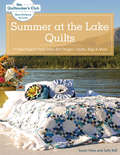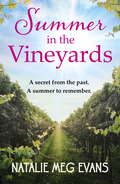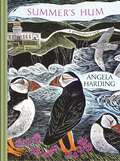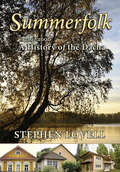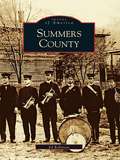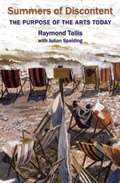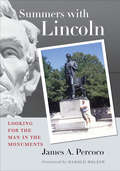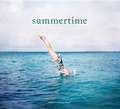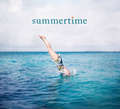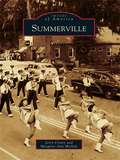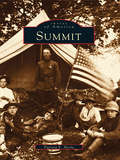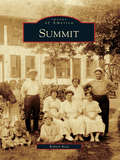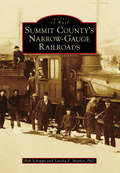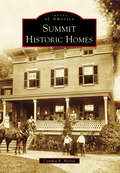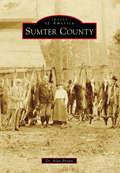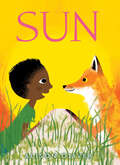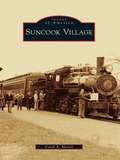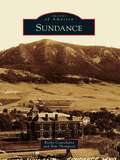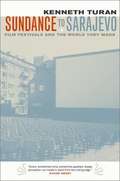- Table View
- List View
Summer at the Lake Quilts: 11 New Projects from Maw Bell Designs, Quilts, Bags & More (Quiltmaker's Club)
by Susan Maw Sally BellGet ready to picnic with designs for a tote, a sunhat, and nine other projects for the sunny season! Sally Bell and Susan Maw, the beloved pattern makers of Maw-Bell Designs, bring you eleven projects to take you outside for a feast with your loved ones. These traditional-with-a-twist designs are casual and stylish, and make the perfect setting for an outdoor getaway. Make six quilts, a picnic tote, a backpack, pillows, a sweet sunhat, and an ant pincushion—and enjoy your next sunny day outdoors!
Summer in the City of Roses
by Michelle Ruiz KeilInspired by the Greek myth of Iphigenia and the Grimm fairy tale "Brother and Sister," Michelle Ruiz Keil's second novel follows two siblings torn apart and struggling to find each other in early '90s Portland. All her life, seventeen-year-old Iph has protected her sensitive younger brother, Orr. But this summer, with their mother gone at an artist residency, their father decides it&’s time for fifteen-year-old Orr to toughen up at a wilderness boot camp. When their father brings Iph to a work gala in downtown Portland and breaks the news, Orr has already been sent away against his will. Furious at her father&’s betrayal, Iph storms off and gets lost in the maze of Old Town. Enter George, a queer Robin Hood who swoops in on a bicycle, bow and arrow at the ready, offering Iph a place to hide out while she tracks down Orr. Orr, in the meantime, has escaped the camp and fallen in with The Furies, an all-girl punk band, and moves into the coat closet of their ramshackle pink house. In their first summer apart, Iph and Orr must learn to navigate their respective new spaces of music, romance, and sex-work activism—and find each other before a fantastical transformation fractures their family forever. Told through a lens of magical realism and steeped in myth, Summer in the City of Roses is a dazzling tale about the pain and beauty of growing up.
Summer in the Vineyards: a delicious summer tale of hidden secrets and eternal love
by Natalie Meg EvansA gorgeous novel set in the French countryside. Perfect for fans of The Keeper of Lost Things and The Hourglass.Shauna Vincent has just learned that the job she set her heart on has gone to a well-connected rival. Devastated, she accepts an offer from an old family friend, and soon Shauna is deep in the French countryside with endless hours to explore the magical landscape around her. But can the charming Laurent de Chemignac, owner of the local chateau, help her untangle the secret that this little French castle amongst the vines might be hiding...'Natalie's books are a treasure trove of vibrant, vivid stories, memorable characters and pacy writing!' Tracy Rees, bestselling author of Amy Snow and The HourglassAlso by Natalie Meg Evans:The Wardrobe MistressThe Girl who Dreamed of ParisThe Dress Thief[Summer in the Vineyards was previously published as A Gown of Thorns]
Summer of Hamn
by Chuck DThe tragedy of gun violence is depicted in annotated illustrations that illuminate a society gone hamn; from legendary hip-hop artist Chuck D (Public Enemy, Prophets of Rage, etc.)—Selected for the In the Margins Book Awards 2024 Nonfiction Recommendation List"With his latest work of graphic nonfiction, Chuck D uses his art and hip-hop rhymes to show how the US has been held hostage by gun violence and a growing sense of hopelessness . . . A focused, fresh, urgent text filled with pictures worth 1,000 words and rhymes worth thousands more." —Kirkus Reviews, Starred ReviewIN SUMMER OF HAMN, legendary hip-hop artist Chuck D takes on gun violence with rhythmic, inventive writing and passionately raw art. He has long spoken out against gun violence, including how it intersects with rap and hip-hop culture. Summer of Hamn is the bound journal Chuck D carried with him in the summer of 2022—a summer marked by a particularly high rate of gun death.In these pages, victims are memorialized, politicians are skewered, and vehement pleas to eradicate gun violence are made. Jaw-dropping statistics (40% of all personal guns in the world are owned by US citizens; there are 100 million more guns in the US than there are citizens) intersect with poetic reflections ("Another mall shooting seems normalized in Columbus / Raining outside in Ohio / Raining inside folks panic / Inside hearing shots bust"), all written in Chuck's hand over vibrant, utterly original, neoexpressionist ink and watercolor art.This book is the follow-up to STEWdio the debut trilogy on Chuck D's Enemy Books imprint, in which he invented a new medium—the "naphic grovel"—a bound journal brimming with his observations and reflections of current events in both art and prose. Summer of Hamn is the second release on the imprint.
Summer's Hum: part of a beautiful new series from beloved illustrator and print-maker Angela Harding
by Angela Harding'The wildflower bank outside my window hums and buzzes. At midday, the summer sun spreads the perfume of roses and honeysuckle to every corner.'Summer's Hum is the second book in a stunning seasonal quartet from beloved printmaker and illustrator Angela Harding. Each title in this pocket-sized series takes readers on a journey through the seasons, reflecting Angela's observations as the nature around her transforms and evolves over the course of a year. Taking in landscapes across the UK including views from her home studio in Rutland, to the Scottish wilderness, via the low-lying marshlands of Suffolk and the windswept hills of Yorkshire, the beautiful illustrations and evocative imagery of the prose make this the perfect book for nature lovers and art lovers everywhere.Featuring over thirty of Angela Harding's favourite prints alongside observations taken from her books A Year Unfolding, Wild Light and Still Waters & Wild Waves, each short, small book in this seasonal collection is a beautiful new way to enjoy Angela's work and celebrate nature and wildlife across the UK at all times of year.Collect all four titles: Spring Unfurled, Summer's Hum, Falling into Autumn, Winter's Song.
Summer's Hum: part of a beautiful new series from beloved illustrator and print-maker Angela Harding
by Angela Harding'The wildflower bank outside my window hums and buzzes. At midday, the summer sun spreads the perfume of roses and honeysuckle to every corner.'Summer's Hum is the second book in a stunning seasonal quartet from beloved printmaker and illustrator Angela Harding. Each title in this pocket-sized series takes readers on a journey through the seasons, reflecting Angela's observations as the nature around her transforms and evolves over the course of a year. Taking in landscapes across the UK including views from her home studio in Rutland, to the Scottish wilderness, via the low-lying marshlands of Suffolk and the windswept hills of Yorkshire, the beautiful illustrations and evocative imagery of the prose make this the perfect book for nature lovers and art lovers everywhere.Featuring over thirty of Angela Harding's favourite prints alongside observations taken from her books A Year Unfolding, Wild Light and Still Waters & Wild Waves, each short, small book in this seasonal collection is a beautiful new way to enjoy Angela's work and celebrate nature and wildlife across the UK at all times of year.Collect all four titles: Spring Unfurled, Summer's Hum, Falling into Autumn, Winter's Song.
Summerfolk: A History of the Dacha, 1710–2000
by Stephen LovellThe dacha is a sometimes beloved, sometimes scorned Russian dwelling. Alexander Pushkin summered in one; Joseph Stalin lived in one for the last twenty years of his life; and contemporary Russian families still escape the city to spend time in them. Stephen Lovell's generously illustrated book is the first social and cultural history of the dacha. Lovell traces the dwelling's origins as a villa for the court elite in the early eighteenth century through its nineteenth-century role as the emblem of a middle-class lifestyle, its place under communist rule, and its post-Soviet incarnation. A fascinating work rich in detail, Summerfolk explores the ways in which Russia's turbulent past has shaped the function of the dacha and attitudes toward it. The book also demonstrates the crucial role that the dacha has played in the development of Russia's two most important cities, Moscow and St. Petersburg, by providing residents with a refuge from the squalid and crowded metropolis. Like the suburbs in other nations, the dacha form of settlement served to alleviate social anxieties about urban growth. Lovell shows that the dacha is defined less by its physical location"usually one or two hours" distance from a large city yet apart from the rural hinterland—than by the routines, values, and ideologies of its inhabitants. Drawing on sources as diverse as architectural pattern books, memoirs, paintings, fiction, and newspapers, he examines how dachniki ("summerfolk") have freed themselves from the workplace, cultivated domestic space, and created informal yet intense intellectual communities. He also reflects on the disdain that many Russians have felt toward the dacha, and their association of its lifestyle with physical idleness, private property, and unproductive use of the land. Russian attitudes toward the dacha are, Lovell asserts, constantly evolving. The word "dacha" has evoked both delight in and hostility to leisure. It has implied both the rejection of agricultural labor and, more recently, a return to the soil. In Summerfolk, the dacha is a unique vantage point from which to observe the Russian social landscape and Russian life in the private sphere.
Summers County (Images of America)
by Ed RobinsonIt was the pull of the steam engine that brought residents to Summers County after the Civil War. With Hinton as a bustling hub of the Chesapeake and Ohio Railroad, Summers County found itself along the path of goods and travelers going to and from Richmond and the Midwest. Surrounded by breathtaking scenery and good mountain air, residents prospered in the county, building beautiful homes and lively communities. Lumber and riverboat traffic also added to the scene, although it was around the C&O that the area's culture truly thrived. Legends such as John Henry, the Steel Drivin' Man who out-drilled a steam drill while digging the Great Bend Tunnel, came to symbolize the grit-and-steel consciousness of this West Virginia county.Life was good, but work was hard. When diesel engines became the norm in the 1950s, Summers County's fabric began to change. Today tourism and recreation are the greatest industries in the area, but residents have not forgotten their past. Each year the county taps into its railroading heritage with festivals and celebrations, and efforts are being made to preserve some of Hinton's unique architecture.
Summers of Discontent
by Raymond Tallis Julian SpaldingSince the time of the ancient Greeks, philosophers have pondered the nature and purpose of the arts, but artists have gone on making them and audiences enjoying them regardless of these musings. None of their theories have met with universal or even popular acceptance. But here is theory that places the arts--all the arts--firmly and squarely within everyone's everyday experiences.Summers of Discontent goes to the heart of the arts. It's an examination of why artists create them in the first place and why we all feel the need for them. Raymond Tallis thinks the arts spring from our inability as humans fully to experience our experiences; from our hunger for a more rounded, more complete sense of the world.Tallis's thesis is original and fresh, down-to-earth and life-enhancing. Above all it is practical and intelligible. It will inspire anyone who feels the creative urge today, or anyone who wants to understand why and how the arts enrich their lives and those of others.Raymond Tallis is a leading academic doctor, poet, philosopher, and cultural critic. Author of more than twenty books, he was until his retirement professor of geriatric medicine at the University of Manchester.Julian Spalding was director, successively of Sheffield and Manchester Art Galleries, and latterly of the Gallery of Modern Art in Glasgow. He has written over a dozen books on art historical subjects and curated many exhibitions.
Summers with Lincoln: Looking for the Man in the Monuments
by James A. PercocoA journey across America revealing &“the history of how seven of these monuments came to be . . . and what they mean to us today&” (The Washington Times). Across the country, in the middle of busy city squares and hidden on quiet streets, there are nearly two hundred statues erected in memory of Abraham Lincoln. No other American has ever been so widely commemorated. A few years ago, Jim Percoco, a history teacher with a passion for both Lincoln and public sculpture, set off to see what he might learn about some of these monuments—what they meant to their creators and to the public when they were unveiled, and what they mean to us today. The result is a fascinating chronicle of four summers on the road looking for Lincoln stories in statues of marble and bronze. Percoco selects seven emblematic works, among them Thomas Ball&’s Emancipation Group, erected east of the Capitol in 1876 with private funds from African Americans and dedicated by Frederick Douglass; Augustus Saint-Gaudens&’s majestic Standing Lincoln of 1887 in Chicago; Paul Manship&’s 1932 Lincoln the Hoosier Youth, in Fort Wayne, Indiana; and Gutzon Borglum&’s 1911 Seated Lincoln, struggling with the pain of leadership, beckoning visitors to sit next to him on his metal bench in Newark, New Jersey. At each stop, Percoco chronicles the history of the monument, spotlighting its artistic, social, political, and cultural origins. His descriptions draw fresh meaning from mute stone and cold metal—raising provocative questions not just about who Lincoln might have been, but about what we&’ve wanted him to be in the monuments we&’ve built.
Summertime
by Joanne DuganSummer is the best season of all, with its long days, blue skies, and endless horizons. Summertime collects more than 100 photos that capture the essence of the season from such highly acclaimed photographers as Joel Meyerowitz, Martin Parr, and Peter Marlow. Quotes from luminaries intermingle with dreamy pictures--sandy toes, empty docks, blue water--that instantly evoke the perfect summer moment. A jacketed hardcover, Summertime is casual, elegant, and ideally sized for the summer cottage coffee table--the perfect gift for weekend hosts, or those who long for an escape to their favorite season all year round.
Summertime
by Joanne DuganSummer is the best season of all, with its long days, blue skies, and endless horizons. Summertime collects more than 100 photos that capture the essence of the season from such highly acclaimed photographers as Joel Meyerowitz, Martin Parr, and Peter Marlow. Quotes from luminaries intermingle with dreamy pictures—sandy toes, empty docks, blue water—that instantly evoke the perfect summer moment. A jacketed hardcover, Summertime is casual, elegant, and ideally sized for the summer cottage coffee table—the perfect gift for weekend hosts, or those who long for an escape to their favorite season all year round.
Summerville
by Margaret Ann Michels Jerry CrottySummerville's original motto, Sacra Pinus Esto, "The Pine is Sacred," hints at how serious the founders were about protecting their towering indigenous pines. Summerville owes its settlement--and early 20th-century development as an international tourism destination--to the fragrant cool air provided by the shade of the grand pines. Settled in the late 1600s by plantation owners along the Ashley River as an escape from summer heat, Summerville later became a retreat from cold northern winters. Today the town is known for its annual Flowertown Festival. The new town slogan, "The Flower Town in the Pines," is a friendlier version of the first, combining healthy respect for the ancient pines with love for the multicolored blossoms that appear anew each spring. The village is a combination of small town and bustling suburb, with plenty of Southern history to explore.
Summit (Images of America)
by Patricia E. MeolaWith a history dating back to 1664, Summit, New Jersey, has evolved from a pastoral town of farms and rolling hills to a populated suburb of Manhattan.In this original collection of images, author and local historian Patricia E. Meola takes readers on a journey into Summit's past. Witness the growth and change that have occurred in Summit since its incorporation in 1899 in this fascinating pictorial history. Through nearly 200 postcard images, Summitcelebrates a city known for its gracious, tree-lined streets, the reputation of its public and private schools, the activism of countless city volunteers, and its thriving opportunities for culture and adult education. In the early days of the community's development, many residents were seasonal (this attribute of the population changed as it became easier to live in the country and work in the city). Some of the postcards that were sent to friends and relations by early summer inhabitants have been reproduced in this book.
Summit (Images of America)
by Robert KottSummit, fittingly named after its location astride a rise, was built on that low ridge crossed by travelers seeking a convenient route into America's interior. As a portal to the North American interior, Summit's land has witnessed the travels and pauses of Native Americans, French explorers and missionaries, fur traders, the English, and finally Colonial Americans. To this day, it remains synonymous with unsurpassed transportation advantages, having stimulated considerable commercial, industrial, and urban growth. From its earliest hut to its latest futuristic library, Summit has played an irreplaceable role in the progress of the United States.
Summit County's Narrow-Gauge Railroads (Images of Rail)
by Bob Schoppe Sandra F. MatherSummit County's Narrow-Gauge Railroads tells the story of the two railroads that fought for dominance in Summit County, Colorado, during the late 1800s and early 1900s: the Denver, South Park & Pacific and the Denver & Rio Grande. The two railroads developed an intense rivalry as they sought to monopolize the county's economic potential. Altitude, heavy winter snow, and rugged mountainous terrain combined to provide a unique set of challenges to company management as well as to the crews as they battled to lay the tracks and provide much-needed rail service to the residents and businesses of the county. Intimately tied to the mining economy, the fortunes of the railroads plummeted when the mining economy collapsed. Although poorly financed and poorly built, the railroads changed the living conditions for county residents. Without the railroads bringing the necessary equipment and lumber, nine huge gold-dredging boats would not have scoured the county's major waterways between 1898 and 1942.
Summit Historic Homes (Images of America)
by Cynthia B. MartinOriginally sought out by city dwellers as a refuge from the tribulations of urban life, Summit developed from a bucolic rural spot in 1836 to a fully established suburb by 1940. The town's growth was intrinsically tied to the development of the railroad and the convenience of the commute it offered to nearby New York City. The houses constructed during these years reflected their owner's wealth, social standing, and aesthetic sensibilities, and exemplified the trends of their times. Some of these houses served as summer residences; others as primary dwellings. Some were designed by well-known architects; others by local talent. Many of these residences are still standing, although some have been altered or even demolished to suit modern lifestyles. Today, many Summit residents still commute to New York. Summit Historic Homes tells the story of Summit's early development by focusing on the expansion of the railroad and the houses built by the city dwellers who moved here as a result.
Summit Up
by Anton KazlauciunasThe more we look, the more we see. The more we see, the more we understand. With our eyes we see, we ruminate, speculate, compare, compose, even cogitate a little, animadvert perhaps, create balance, empathy, order out of chaos, understanding rises from conflict, beauty out of the undefined, trust replaces prejudice and suspicion, light emerges from the darkness, love out of hate, peace from war. We create hopes of dreams, belief out of impossibility, reality materializes from imagination. And so artists draw. Please read the pictures and think for yourselves.
Sumter County
by Alan BrownSumter County was founded on December 18, 1832, on land ceded to the United States by the Choctaw Indians in the Treaty of Dancing Rabbit Creek. Almost immediately, settlers began pouring in from Georgia, Virginia, Tennessee, and the Carolinas. In the 19th and early-20th centuries, most of the residents were farmers; however, following the infestation of the boll weevil, many turned to raising cattle and growing timber. Every November, hundreds of hunters descend upon Sumter County in hopes of harvesting one of the thousands of deer that live on the rolling prairies and in the oak forests lining the Tombigbee River. With the help of Ruby Pickens Tartt, scores of ethnomusicologists, including John and Alan Lomax, traveled hundreds of miles to the red clay country of Sumter County in the 1930s, 1940s, and 1950s to record African American folk songs from people like Vera Hall and Dock Reed.
Sun
by Alison OliverSun, a sporty boy, reconnects with his artistic side in this gorgeous, joyful celebration of creativity that offers an expanded and appealing model for boyhood. Sun loves everything about playing soccer: the cheers, the competition, the winning. But he feels as though something is missing. When he sees his younger brother spread out on the floor, creating a wondrous piece of art, he remembers how much he loves to make things. He goes to the beach to think, and it&’s there that a magical encounter with a fox helps him reconnect with a long-forgotten source of happiness. Simple words and stunning illustrations pair to show us there is more than one way to be a boy…and remind us of the deep satisfaction of creativity.
Sunbeam on the Astronaut
by Steven CerioA long-awaited collection of comics, art, and stories by artist Steven Cerio that explores silly, psychedelic, and strange worlds.<P><P> Smiling cartoon critters carouse with threatening cutout whales against a shifting comic landscape in these unique illustrated stories. The psychedelic meets Saturday morning cartoons in stories with such intriguing titles as "A Private History of Sunbeams and Head Colds," "The Add Witch in The Berry Patch," and "Ninny Noonday Ninny."Steven Cerio is a prominent rock poster and magazine illustrator. His work is best known from his ongoing collaboration with San Francisco-based performance art and music group The Residents.
Suncook Village
by Carol MartelLocated within the boundaries of the towns of Allenstown and Pembroke, Suncook, first granted as a township in 1728, has developed a rich history all its own. Railroad transportation was instrumental to the establishment and growth of three large textile mills. The first railroad system, the Concord and Portsmouth line, began in 1852. A second line, the Suncook Valley Railroad, followed in 1869. Drawn by advertisements in Canadian newspapers, French Canadian workers began migrating from Quebec in large numbers. By the late 1800s, Suncook had become known as "le Petit Canada." The power of the Suncook and Merrimack Rivers, scenic beauty in the area, and the connectivity brought through transportation helped transform a small industrial village into a vibrant and lasting community.
Sundance
by Rocky Courchaine Pam ThompsonSundance, in the northeast corner of Wyoming, may not be the only place with that name, but it is the original Sundance--the place where the Kid got his name. There was no settlement of any sort when Crook County was created in 1875. The town was founded in 1878, named after the mountain that stands south of town where the Plains tribes held their sun dance ceremonies. Sundance is not that different from the many other small towns that sprang to life in the boom of gold, cattle, and oil throughout the West, but it is different in that it has ridden through the booms and the busts and still survives. This book contains images of people's lives as they worked and played, lived and died. It tells of those who passed through, and those who stayed and helped the community establish its roots and grow.
Sundance to Sarajevo: Film Festivals and the World They Made
by Kenneth TuranA journalistic account of all the superficial glitz that we associate with film festivals, along with an account of the serious business that goes on there, and of the politics behind the glamor. There have been books about individual festivals, but never anything as comprehensive as this.
Sundance to Sarajevo: Film Festivals and the World They Made
by Kenneth TuranAlmost every day of the year a film festival takes place somewhere in the world--from sub-Saharan Africa to the Land of the Midnight Sun. Sundance to Sarajevo is a tour of the world's film festivals by an insider whose familiarity with the personalities, places, and culture surrounding the cinema makes him uniquely suited to his role. Kenneth Turan, film critic for the Los Angeles Times, writes about the most unusual as well as the most important film festivals, and the cities in which they occur, with an eye toward the larger picture. His lively narrative emphasizes the cultural, political, and sociological aspects of each event as well as the human stories that influence the various and telling ways the film world and the real world intersect. Of the festivals profiled in detail, Cannes and Sundance are obvious choices as the biggest, brashest, and most influential of the bunch. The others were selected for their ability to open a window onto a wider, more diverse world and cinema's place in it. Sometimes, as with Sarajevo and Havana, film is a vehicle for understanding the international political community's most vexing dilemmas. Sometimes, as with Burkina Faso's FESPACO and Pordenone's Giornate del Cinema Muto, it's a chance to examine the very nature of the cinematic experience. But always the stories in this book show us that film means more and touches deeper chords than anyone might have expected. No other book explores so many different festivals in such detail or provides a context beyond the merely cinematic.
